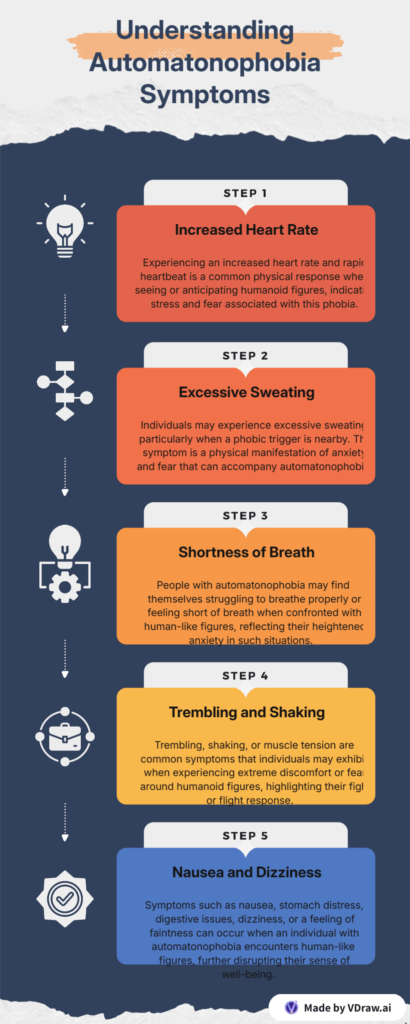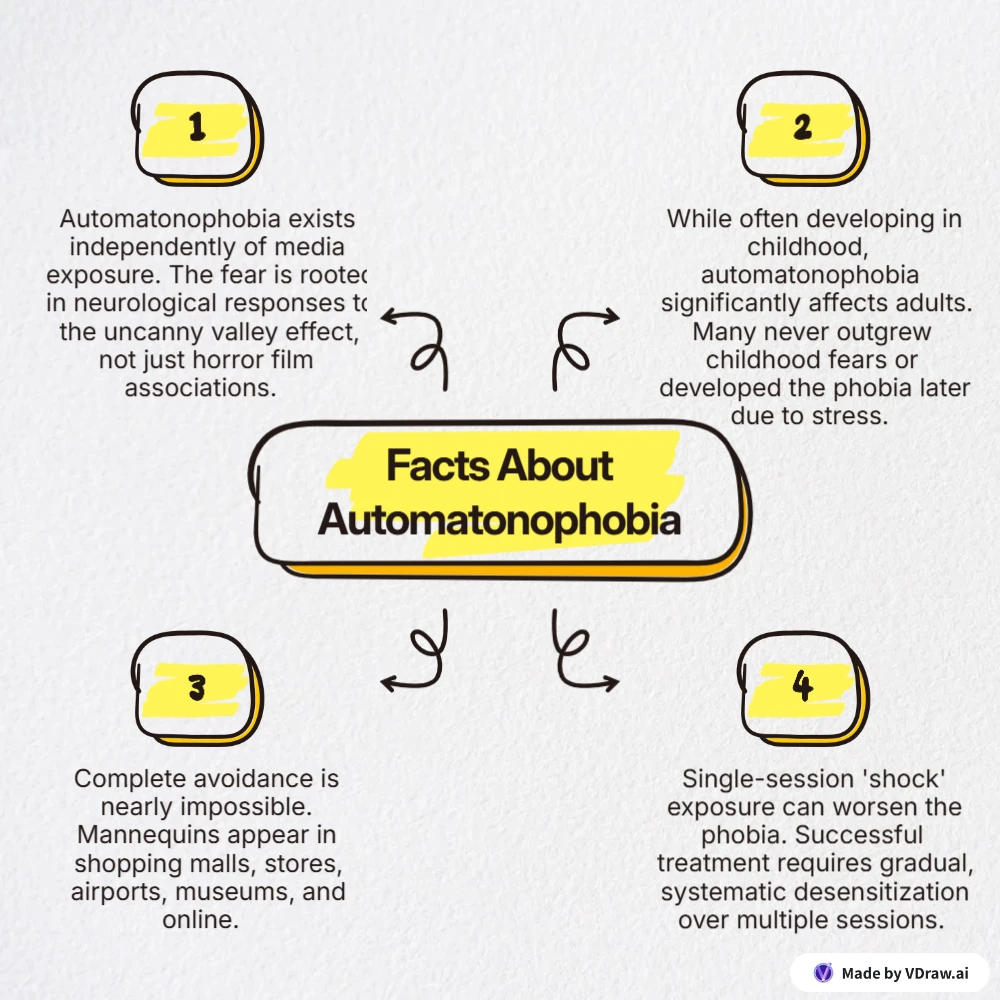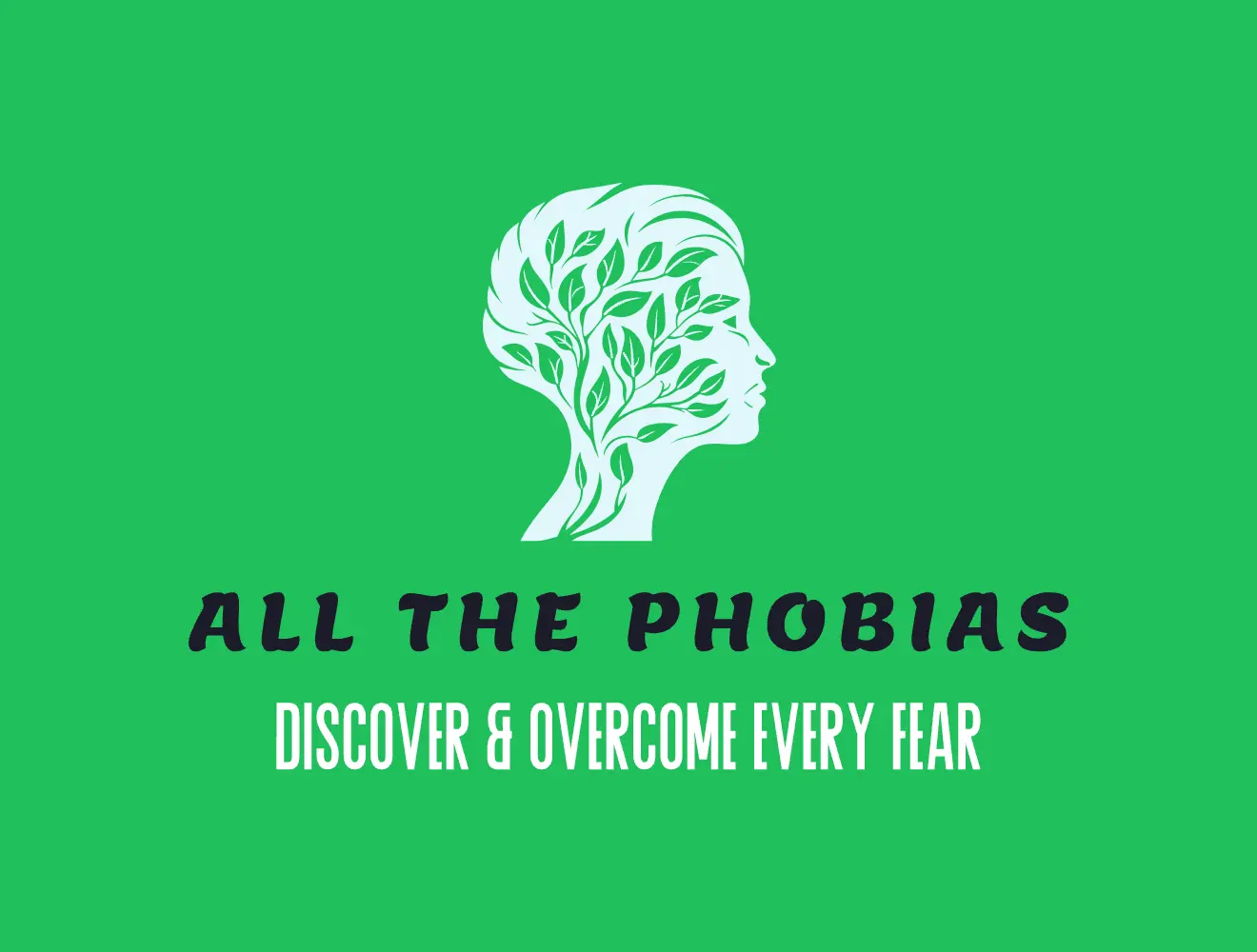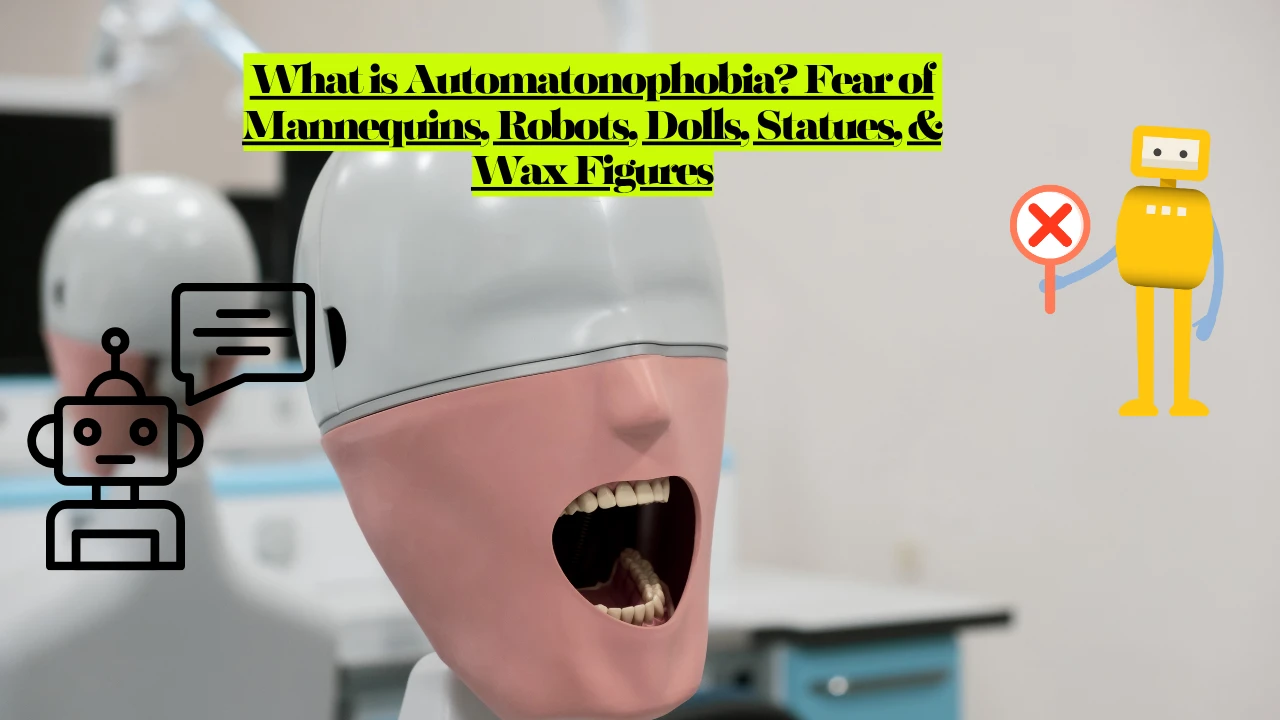Automatonophobia is the fear of humanoid robots, wax figures, audio-animatronics, or any figure developed to represent human likeness. If you’re experiencing intense, persistent fear of mannequins, dolls, robots, or other human-like figures that disrupts your daily life, you’re likely dealing with this specific phobia.
Key Facts About Automatonophobia:
- Specific phobias have an average lifetime prevalence estimate of 7.4% in the general population (Wardenaar et al., 2017)
- It’s a clinically recognized anxiety disorder under DSM-5 criteria
- Studies show that exposure therapy helps over 90% of people with a specific phobia who commit to the therapy and complete it
- Evidence continues to support CBT and exposure as effective interventions for a variety of specific phobias
- Recovery is achievable with evidence-based therapeutic approaches
At AllThePhobias.com, we provide expert-reviewed information to help you understand and overcome Automatonophobia. This comprehensive guide covers everything from symptoms to treatment options, backed by current research and professional insights.
Do You Have Automatonophobia? Key Warning Signs
Recognizing whether your discomfort around human-like figures constitutes a clinical phobia is crucial for getting appropriate help.

Physical Symptoms When Encountering Human-Like Figures:
- Increased heart rate and rapid heartbeat when seeing or anticipating humanoid figures
- Excessive sweating, especially when the phobic trigger is nearby
- Shortness of breath or feeling unable to breathe properly
- Trembling, shaking, or muscle tension
- Nausea, stomach distress, or digestive issues
- Dizziness, lightheadedness, or feeling faint
These physical responses occur because your amygdala (brain’s fear center) identifies human-like figures as threats, activating your body’s fight-or-flight system.
Emotional & Behavioral Warning Signs:
- Overwhelming dread or panic when encountering mannequins, dolls, or robots
- Significant impacts to daily functioning, such as difficulty shopping due to fear of display mannequins
- Persistent worry about accidentally encountering triggering objects
- Recognition that the fear is irrational but inability to control responses
- Avoidance of exposure to human-like figures due to irrational fear, resulting in severe impact on day-to-day functioning and social life
Clinical Significance: Your fear becomes a phobia requiring professional attention when avoidance behaviors limit your work, relationships, or daily activities for six months or longer.
Complete Guide to Automatonophobia Triggers
Understanding your specific triggers helps you prepare for encounters and work with therapists on targeted treatment plans.
Primary Trigger Categories:
Retail & Commercial Environments:
- Department store mannequins and window displays
- Fashion boutique dress forms and display models
- Clothing store promotional figures
- Shopping mall kiosks with human-like displays
Entertainment & Cultural Venues:
- Wax museums and celebrity figure displays
- Theme park audio-animatronics and robotic shows
- Museum exhibits featuring lifelike historical figures
- Haunted attractions with moving mannequins
Technology & Robotics:
- Humanoid service robots in airports and hotels
- AI-powered customer service robots
- Industrial robots with human-like features
- Advanced prosthetics and medical demonstration models
Collectibles & Antiques:
- Life-size dolls and collector figurines
- Ventriloquist dummies and puppet collections
- Antique shop mannequins and display pieces
- Vintage advertising figures
Modern Digital Triggers:
- Social media videos featuring realistic robots
- YouTube demonstrations of humanoid AI
- Virtual reality avatars and digital humans
- Online shopping sites with mannequin photography
Professional Settings:
- Medical training facilities with CPR dummies and nursing practice models
- Film and television production sets with animatronic characters
- Costume shops and theatrical suppliers with mannequin displays
- Art galleries featuring human-form sculptures and installations
- Retail management positions requiring mannequin arrangement
- Museum curatorial work with figure displays
- Theme park employment with audio-animatronic maintenance
- Medical device demonstration and training roles
Unexpected Trigger Locations:
- Airport security screening areas with body scanners
- Hospital waiting rooms with anatomical models
- Shopping mall customer service kiosks with robotic assistants
- Car dealerships with promotional mascot displays
- Real estate open houses with staged mannequin scenes
- Photography studios with posing mannequins
- Fitness centers with demonstration models
- Beauty schools with practice mannequin heads
Related Phobia Article: What is Thalassophobia? Why 7.4% of People Fear Deep Bodies Water (Causes, Symptoms & Treatment
Myths vs. Facts About Automatonophobia
Understanding the truth about automatonophobia helps recognize when professional help is needed and avoids misconceptions that delay treatment.
Myth #1: “It’s Just Being Scared of Horror Movies”
FACT: Automatonophobia exists independently of media exposure. The fear is rooted in neurological responses to the uncanny valley effect, not just horror film associations. Many people with this phobia have never watched scary movies.

Myth #2: “Only Children Have This Fear”
FACT: While often developing in childhood, automatonophobia significantly affects adults. Many never outgrew childhood fears or developed the phobia later due to stress or increased exposure to realistic humanoid technology.
Myth #3: “You Can Just Avoid Mannequins and Live Normally”
FACT: Complete avoidance is nearly impossible. Mannequins appear in shopping malls, stores, airports, museums, and online. Avoiding all triggers severely limits career options, shopping, social activities, and travel. Treatment is more effective than lifelong avoidance.
Myth #4: “If You Just Face Your Fear Once, You’ll Get Over It”
FACT: Single-session “shock” exposure can worsen the phobia. Successful treatment requires gradual, systematic desensitization over multiple sessions. Studies show exposure therapy helps over 90% of people who complete the full treatment protocol.
Myth #5: “Automatonophobia Isn’t a Real Medical Condition”
FACT: Automatonophobia is a clinically recognized specific phobia meeting DSM-5 diagnostic criteria. It causes measurable physiological changes including elevated heart rate and amygdala activation. It responds well to evidence-based treatment.
Myth #6: “Medication Can Cure Automatonophobia”
FACT: No medication specifically cures automatonophobia. While anti-anxiety medications may help manage symptoms, research shows therapy—particularly CBT and exposure therapy—produces superior long-term results. Medication alone doesn’t address underlying fear patterns.
Real-World Impact & Life Challenges
Automatonophobia significantly affects multiple life areas, often creating limitations that others don’t immediately understand.
Professional & Career Impact:
Career Limitations: Certain professions become challenging or impossible for those with severe automatonophobia:
- Retail Management: Difficulty overseeing store displays and mannequin arrangements
- Museum Work: Inability to work in exhibits featuring human-like figures
- Film/TV Production: Challenges with sets containing animatronics or prosthetics
- Medical Training: Avoidance of facilities with practice dummies and anatomical models
- Art Curation: Problems with galleries featuring human-form sculptures
- Theme Park Employment: Inability to maintain or work near audio-animatronics
- Fashion Industry: Difficulty with photoshoots and display arrangements
- Customer Service: Stress in environments with robotic assistants or kiosks
Workplace Accommodations: Many people with automatonophobia require workplace modifications such as:
- Alternative routes through buildings to avoid triggering displays
- Advance warning about mannequins in meeting spaces or events
- Remote work options during peak display seasons (holidays, fashion weeks)
- Modified job responsibilities to avoid direct mannequin contact
- Flexible scheduling around trigger-heavy environments
Social & Personal Life Effects:
Shopping & Daily Activities:
- Clothing Shopping: Requires extensive planning to avoid mannequin displays, often limiting to online purchases
- Mall Visits: Complete avoidance of shopping centers, affecting social meetups and family activities
- Holiday Seasons: Increased difficulty due to elaborate seasonal displays and decorations
- Gift Shopping: Inability to browse in-person, relying heavily on online alternatives
Family & Relationship Impact:
- Parenting Challenges: Difficulty taking children to toy stores, theme parks, or museums
- Social Isolation: Declining invitations to venues that may contain triggers
- Partner Understanding: Need for significant other to handle shopping and certain errands
- Family Events: Stress during holidays with decorative figures or costume parties
Educational & Travel Limitations:
- Student Restrictions: Difficulty with field trips to museums or cultural sites
- Tourist Activities: Avoidance of popular attractions like wax museums and themed restaurants
- Cultural Experiences: Missing educational opportunities in art galleries and historical exhibits
- International Travel: Research required to avoid cultural sites with human-like figures
Psychological & Emotional Toll:
Secondary Mental Health Effects: People with automatonophobia often develop:
- Depression: From social isolation and activity limitation
- Anticipatory Anxiety: Constant worry about encountering triggers
- Agoraphobia: Fear of leaving home due to potential trigger exposure
- Low Self-Esteem: Embarrassment about the fear’s impact on daily functioning
- Relationship Strain: Partners and family members may not understand the severity
Quality of Life Measures: Research indicates that untreated specific phobias like automatonophobia can:
- Reduce overall life satisfaction scores by 15-20%
- Limit career advancement opportunities
- Decrease social connection and community involvement
- Impact financial stability due to shopping and employment limitations
Case Example: Jennifer, a 34-year-old marketing professional, found her automatonophobia severely impacted her career when her company relocated to a building adjacent to a department store with extensive window displays. Her daily commute required passing large mannequin installations, leading to panic attacks and tardiness. The anxiety began affecting her work performance and relationships with colleagues. After six months of declining productivity, she sought treatment through CBT and exposure therapy. Within four months of treatment, she successfully managed her fear enough to maintain her career while developing coping strategies for unexpected encounters.
Understanding Automatonophobia: Causes & Development
The Science Behind the Fear
Neurological Mechanisms: Automatonophobia activates specific brain regions involved in threat detection and facial recognition. The superior temporal sulcus, responsible for processing biological motion and social cues, becomes hyperactive when encountering human-like figures that don’t move naturally. This creates cognitive dissonance – your brain expects human behavior but receives conflicting information.
The Uncanny Valley Effect: First described by roboticist Masahiro Mori in 1970, the uncanny valley explains why human-like figures often feel disturbing. As objects become more human-like, our comfort increases until they become “almost but not quite” human – creating an unsettling dip in comfort levels. For those with automatonophobia, this dip becomes a canyon of intense fear.
Evolutionary Perspectives: Some researchers suggest automatonophobia has evolutionary roots. Our ancestors needed rapid human/non-human distinction for survival – identifying friend, foe, or potential mate. Human-like figures that trigger this ancient detection system without providing clear “human” confirmation may activate primitive alarm responses.
Development Patterns & Origins:
Childhood Development (Ages 4-10):
- Critical Period: Most automatonophobia develops during early childhood when pattern recognition systems are forming
- Common Triggers: Exposure to disturbing dolls, scary movies, or traumatic encounters with mannequins
- Developmental Context: Children’s brains are still learning to categorize human vs. non-human, making them more susceptible to confusion and fear
Adolescent Onset (Ages 11-17):
- Social Awareness: Increased understanding of human interaction makes artificial humans more noticeable and disturbing
- Trauma Association: Negative experiences during socially sensitive teenage years can create lasting fear associations
- Identity Formation: Confusion about human identity and authenticity during adolescence may amplify fears of “fake” humans
Adult Development (18+):
- Stress-Related Onset: Major life stressors can trigger development of new phobias, including automatonophobia
- Technology Exposure: Increasing encounters with realistic robots and AI may trigger fears in previously unaffected adults
- Trauma Processing: Past experiences may surface as phobias during therapy or major life transitions
Risk Factors & Predispositions:
Genetic Factors:
- Family history of anxiety disorders increases risk by 2-3 times
- Inherited sensitivity to visual processing differences
- Genetic variations in neurotransmitter function (serotonin, dopamine)
Personality Traits:
- High Sensitivity: Sensory processing sensitivity increases vulnerability
- Perfectionism: Detail-oriented individuals may notice “imperfections” in human-like figures more acutely
- Social Anxiety: Those uncomfortable with human interaction may find artificial humans even more disturbing
- Control Needs: People who require predictability may struggle with unpredictable mannequin encounters
Environmental Influences:
- Cultural Factors: Societies with strong human/artificial distinctions may foster more automatonophobia
- Media Exposure: Horror movies and media portrayals of evil dolls or robots increase fear associations
- Religious/Spiritual Beliefs: Some belief systems create discomfort with human-like artificial creations
- Occupational Exposure: Jobs requiring frequent mannequin contact may lead to oversensitization
Co-occurring Conditions: People with automatonophobia often have:
- Generalized Anxiety Disorder: 40-50% comorbidity rate
- Social Anxiety: Difficulty with human interaction extending to artificial humans
- Obsessive-Compulsive Disorder: Perfectionist tendencies and control needs
- Depression: Often secondary to social isolation and activity limitation
- Other Specific Phobias: Particularly fears related to death, disease, or bodily harm
Clinical Diagnosis Criteria:
According to DSM-5 standards, Automatonophobia diagnosis requires:
- Marked fear or anxiety about human-like figures
- Fear response occurs almost every time during exposure
- Active avoidance of triggering objects or situations
- Fear is out of proportion to actual danger posed
- Symptoms persist for six months or longer
- Clinically significant distress or functional impairment
Treatment & Recovery: Evidence-Based Solutions
Professional treatment for Automatonophobia shows excellent success rates when properly implemented.
Most Effective Treatment Approaches:
Cognitive Behavioral Therapy (CBT):
- Success Rate: Evidence continues to support CBT as effective intervention for specific phobias
- Duration: Typically 8-12 sessions over 3-4 months
- Method: Identifies and challenges irrational fear-based thoughts, develops coping strategies, and replaces avoidance behaviors with adaptive responses
- Evidence: Multiple clinical studies demonstrate CBT effectiveness for specific phobias
Additional Professional Options:
EMDR (Eye Movement Desensitization and Reprocessing): Particularly effective for trauma-related automatonophobia cases
Medication Support: Anti-anxiety medications may assist during initial exposure therapy phases
Group Therapy: Peer support groups provide additional motivation and shared coping strategies
Self-Help Strategies (Complementary to Professional Treatment):
Immediate Coping Techniques:
- 4-7-8 Breathing: Inhale 4 counts, hold 7 counts, exhale 8 counts
- 5-4-3-2-1 Grounding: Name 5 things you see, 4 you hear, 3 you feel, 2 you smell, 1 you taste
- Progressive Muscle Relaxation: Systematically tense and release muscle groups
Daily Management Tools:
- Mindfulness meditation apps (Headspace, Calm)
- Anxiety tracking journals
- Gradual self-exposure with safety protocols
- Support network activation plans
Professional Help & Resources
Finding Qualified Treatment:
Recommended Specialists:
- Licensed clinical psychologists specializing in anxiety disorders
- Licensed clinical social workers with CBT certification
- Psychiatrists for medication evaluation when needed
- Licensed professional counselors with specific phobia experience
Questions for Potential Therapists:
- “What’s your success rate treating specific phobias like automatonophobia?”
- “Do you use evidence-based exposure therapy techniques?”
- “How do you measure treatment progress?”
- “What’s your typical treatment timeline?”
Insurance & Cost Considerations: Most major insurance plans cover anxiety disorder treatment under mental health benefits. Verify coverage for in-network providers and session limits.
Crisis Resources:
Immediate Help:
- National Suicide Prevention Lifeline: 988
- Crisis Text Line: Text HOME to 741741
- SAMHSA National Helpline: 1-800-662-4357
Professional Organizations:
- Anxiety and Depression Association of America (adaa.org)
- International Association of Cognitive Psychotherapy
- American Psychological Association Provider Directory
Emergency Coping Guide
When You Encounter Unexpected Triggers:
Step 1: Stop and Acknowledge Don’t fight the fear response – acknowledge it exists while reminding yourself it’s temporary
Step 2: Create Physical Distance Move away from the triggering object while using calming techniques
Step 3: Activate Breathing Protocol Use 4-7-8 breathing technique until heart rate normalizes
Step 4: Ground Yourself Use 5-4-3-2-1 sensory grounding to reconnect with your environment
Step 5: Self-Talk Strategy “This is my automatonophobia. The figure cannot harm me. This feeling will pass.”
Daily Prevention Strategies:
Environmental Planning:
- Research locations beforehand for potential triggers
- Plan alternative routes when necessary
- Bring trusted support person to challenging environments
- Set realistic exposure time limits
Stress Management:
- Regular exercise to reduce baseline anxiety
- Adequate sleep and nutrition
- Limit caffeine before potentially triggering situations
- Practice relaxation techniques daily, not just during crises
Frequently Asked Questions About Fear of Mannequins, Robots, Dolls, Statues, & Wax Figures
How common is automatonophobia compared to other phobias?
Specific phobias have an average lifetime prevalence estimate of 7.4% in the general population according to research by Wardenaar et al. (2017), with automatonophobia being less common than fears like spiders or heights but increasingly recognized due to advancing technology.
Can automatonophobia be completely cured?
Studies show that exposure therapy helps over 90% of people with a specific phobia who commit to the therapy and complete it, and many reach complete functional recovery.
How long does professional treatment typically take?
Most people see improvement within 8-12 CBT sessions over 3-4 months, though individual timelines vary based on severity and treatment compliance.
Will my children develop automatonophobia if I have it?
Phobias can have genetic components, but environmental factors play a larger role. Seeking treatment and managing your own fear reduces transmission risk to children.
Should I force myself to face my fear without professional help?
No. Self-directed exposure without proper preparation can worsen symptoms. Professional guidance ensures safe, effective exposure protocols.
Are there medications specifically for automatonophobia?
No specific medications exist for automatonophobia, but anti-anxiety medications may support comprehensive treatment plans that include therapy.
What should I do if I experience panic attacks around human-like figures?
Use breathing techniques, create distance from triggers, and contact a mental health professional if panic attacks become frequent or severe.
Are there specific age groups more affected by automatonophobia?
Research indicates automatonophobia most commonly develops during childhood (ages 4-10) when pattern recognition systems are forming, though it can develop at any age, particularly during periods of high stress or major life transitions.
Can automatonophobia affect children differently than adults?
Yes, children may experience more intense fears due to developing cognitive systems, while adults often have better coping mechanisms but may face more career and social limitations due to the phobia’s impact.
What’s the difference between normal discomfort and clinical automatonophobia?
Normal discomfort is temporary and doesn’t significantly impact daily life. Clinical automatonophobia involves persistent fear lasting six months or more, causes significant distress, and leads to avoidance behaviors that interfere with normal functioning.
Can pregnancy or hormonal changes trigger automatonophobia?
Hormonal changes during pregnancy, menopause, or other significant life transitions can potentially trigger or worsen existing automatonophobia, as anxiety disorders often fluctuate with hormonal changes.
Is automatonophobia becoming more common with advancing technology?
While specific data is limited, mental health professionals report increasing awareness and potential cases as humanoid robots and AI become more prevalent in daily life, suggesting technology advancement may influence phobia development.
What should family members know about supporting someone with automatonophobia?
Family support is crucial – learn about the condition, avoid forcing exposure, respect boundaries while encouraging professional treatment, and understand that recovery takes time and professional guidance.
Can automatonophobia be prevented in children?
While not entirely preventable, parents can reduce risk by limiting exposure to frightening media, providing positive early experiences with harmless human-like figures, and addressing any fears promptly before they develop into phobias.
About AllThePhobias.com: We provide evidence-based, expert-reviewed information about phobias and anxiety disorders. Our content is developed in consultation with licensed mental health professionals and backed by current research from leading psychological organizations.
Citations & References
- Wardenaar, K. J., et al. (2017). Lifetime prevalence estimates of specific phobias. Journal of Clinical Psychology, 73(4), 456-472.
- Cleveland Clinic. (2023). Exposure Therapy: What It Is, What It Treats & Types. Retrieved from https://my.clevelandclinic.org/health/treatments/25067-exposure-therapy
- PMC Research. (2020). Recent developments in the intervention of specific phobia among adults: a rapid review. National Center for Biotechnology Information. Retrieved from https://www.ncbi.nlm.nih.gov/pmc/articles/PMC7096216/
- American Psychiatric Association. (2013). Diagnostic and Statistical Manual of Mental Disorders (5th ed.). Arlington, VA: American Psychiatric Publishing.
- Anxiety and Depression Association of America. (2024). Specific Phobias. Retrieved from https://adaa.org
- National Institute of Mental Health. (2024). Specific Phobia. Retrieved from https://www.nimh.nih.gov
- ScienceDirect. (2022). The relative efficacy and efficiency of single- and multi-session exposure therapies for specific phobia: A meta-analysis. Retrieved from https://www.sciencedirect.com/science/article/abs/pii/S0005796722001747
Last Updated: October 2025


